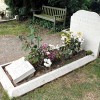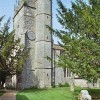In January 1901, the captain of a Spanish steamer died after his ship was swept against a breakwater in Portland Roads. The lifeboat was manned and launched but could not get near the breakwater on account of the sea which was being swept by a violent gale.
The steamer named the Encourt, was from Bilbao and was bound there in ballast from Rotterdam. The crew of 26 were taken to the breakwater fort, and later on board another Spanish vessel. Their ship was badly holed and lay with a list, and sank in nine fathoms of water with the skipper on board.
Along the coast, the seas were high in West Bay, where a boat sank in the harbour. The gale blew down trees, took the roofs off houses, and made the streets dangerous.
Watchnight services had been held in the churches, reported the ‘Bridport News’ of January 1901. There the last moment of the dying year and the opening of the new, were spent in worship and in the parish church the hymn ‘O God our help in ages past’ was sung. Services were also held in the Wesleyan, Baptist and Unitarian chapels.
Meanwhile, far away in South Africa the Boers were making determined attacks and British officers were being killed and wounded. During a fog the Boers were repulsed with a loss of 24 killed including four officers.
In New York, influenza was raging, and a typical headline was: ‘Grip’ reigns in New York.’ Grip was the popular name for ‘flu. It was estimated that nearly 200,000 people in and around the city were suffering from it and it was now in an epidemic state all over the country. Even President McKinley was a sufferer but was recovering.
A great century of progress had closed, with momentous events concerning the British Empire. It was hoped that the enemy would lay down their arms. Dorset had provided horsemen and foot soldiers, meanwhile the Ashanti campaign had been brought to a close in West Africa, and an international force had defeated the aims of the Boxers in China.
Many Bridport bluejackets were in the thick of the fighting in the attempt to relieve Peking. While down under, Lord Hopetoun had been appointed the first Viceroy of Federated Australia. The Indian famine called for public subscription, and Paris had held its great exhibition, though at this point in history Great Britain had more friends in Germany than France. Away East, the Spanish had lost the Philippines to the United States.
Here in this country, the Conservatives had been returned to power and Lord Salisbury was Premier. Dorset again returned a quartet of Conservative members. Mrs. Gladstone, widow of the famous Prime Minister, was buried beside her husband, and the death of Sir Arthur Sullivan, called the greatest of British composers and a marvellous musician, had occurred. He was buried in St. Paul’s. The Bridport paper reflected on all this news.
On that south Dorset coast and going back a century, on August 19, 1800, three women and an infant were struck by lightning, and the infant, who turned out to be the fossilist Mary Anning, was resuscitated by being put into a warm bath. What would have been lost to archaeology if she had not been put in that bath?
Early in the 19th century fossils began to attract local geologists, especially John Crookshanks (alias Lock,) who committed suicide in 1802 because his yearly stipend for collecting fossils was discontinued! And Richard Anning (father of Mary) fell over the Charmouth cliffs by night, did not kill himself, but died soon after, in 1810, of consumption.
It was in the following year, 1811, that Miss Anning found her famous ‘crocodile’ fossil, and sold it to Mr H. Henley, lord of the manor, for £23. It was later presented to the British Museum.
The population of Lyme in 1800 was 1,535; in 1810 it was 1,925. In 1803, three seats were set up a yard from the precipice above the sea beyond the churchyard. The Church Cliffs in those days formed “the great place of resort, the Mall of Lyme, where the belles of the place and the sons of the aristocracy enjoyed the sea breeze.” There was no marine walk then.
People in the early 1800’s were still talking about “a very singular fish” 14 feet long with a tail three feet wide, a circumference of six feet, and with long jaws, which came into the Cobb and was taken. In 1803 a great fire destroyed 42 houses near the Independent Chapel. It started at a baker’s.
In 1817, a breach of 192 feet was made in the southwest part of the Cobb, and several vessels were driven ashore or sank. The Cobb had to be repaired, and work costing well over £30,000 was carried out in the next nine years. Between 1810 and 1816 the annual average of vessels entering the Cobb harbour was 318.
We should be making a mistake if we thought that indecency offences were new: that Bridport paper at the beginning of the 20th century reported that at Weymouth County Police Court in early 1901 a sub-postmaster was summoned “in several instances for such offences of a serious character against young men.”
And a Royal Commission had been appointed to make investigations regarding the “beer poisoning epidemic.” Sickness and death had been caused in England and Wales through poisoning by arsenic.



